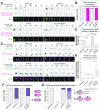Spo13 prevents premature cohesin cleavage during meiosis
- PMID: 30906881
- PMCID: PMC6426077
- DOI: 10.12688/wellcomeopenres.15066.2
Spo13 prevents premature cohesin cleavage during meiosis
Abstract
Background: Meiosis produces gametes through two successive nuclear divisions, meiosis I and meiosis II. In contrast to mitosis and meiosis II, where sister chromatids are segregated, during meiosis I, homologous chromosomes are segregated. This requires the monopolar attachment of sister kinetochores and the loss of cohesion from chromosome arms, but not centromeres, during meiosis I. The establishment of both sister kinetochore mono-orientation and cohesion protection rely on the budding yeast meiosis I-specific Spo13 protein, the functional homolog of fission yeast Moa1 and mouse MEIKIN. Methods: Here we investigate the effects of loss of SPO13 on cohesion during meiosis I using a live-cell imaging approach. Results: Unlike wild type, cells lacking SPO13 fail to maintain the meiosis-specific cohesin subunit, Rec8, at centromeres and segregate sister chromatids to opposite poles during anaphase I. We show that the cohesin-destabilizing factor, Wpl1, is not primarily responsible for the loss of cohesion during meiosis I. Instead, premature loss of centromeric cohesin during anaphase I in spo13 Δ cells relies on separase-dependent cohesin cleavage. Further, cohesin loss in spo13 Δ anaphase I cells is blocked by forcibly tethering the regulatory subunit of protein phosphatase 2A, Rts1, to Rec8. Conclusions: Our findings indicate that separase-dependent cleavage of phosphorylated Rec8 causes premature cohesin loss in spo13 Δ cells.
Keywords: Meiosis; Spo13; cohesin.
Conflict of interest statement
No competing interests were disclosed.
Figures







References
Grants and funding
LinkOut - more resources
Full Text Sources
Molecular Biology Databases

